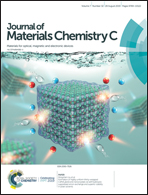A combinatory approach towards the design of organic polymer luminescent materials†
Abstract
Room-temperature phosphorescent (RTP) materials have been widely used in sensing, imaging and display technology. The ability to predict and modulate RTP properties, such as emission color and lifetime, is particularly important for the design of rational materials. Here, we show that by incorporating three different types of acceptor moieties into a polylactide (PLA)-substituted carbazole donor, RTP with different emission colors and lifetimes (with an absolute quantum yield of up to 39.4%) could be generated. Specifically, the chemical conjugation between an n–π* type of luminophore and a π–π* one most likely results in dual RTP while the conjugation between two π–π* types of luminophores produces fluorescence-RTP (F-RTP) dual emission. The consistency between the experimental results and theoretical calculations further validates the observation. To demonstrate the versatility and application potential of these purely organic, biocompatible materials, aqueous nanoparticles were fabricated and used as high-contrast cell imaging agents, given the large Stokes shift of RTP materials.



 Please wait while we load your content...
Please wait while we load your content...